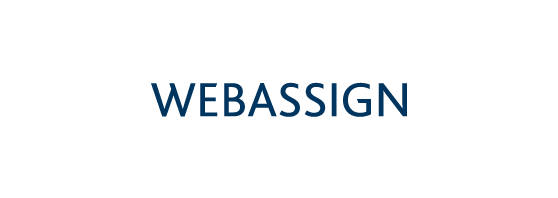Request for consultation
Thanks for your request. You’ll soon be chatting with a consultant to get the answers you need.
Your form is submitting...
{{formPostErrorMessage.message}} [{{formPostErrorMessage.code}}]
Quick Navigation
Overview
WebAssign for Stoker/Tillinger's GENERAL, ORGANIC, AND BIOLOGICAL CHEMISTRY, 8th EDITION, is a flexible and fully customizable online instructional solution that puts powerful tools in the hands of instructors, enabling you to communicate assignments, instantly assess individual student and class performance, and help your students master the course concepts. With its powerful digital platform and chemistry-specific content, you can tailor your course with a wide range of assignment settings, add your own questions and content and access student and course analytics and communication tools.
- Diverse Answers: A flexible and powerful answer evaluator that accepts diverse interpretations so your students are not penalized for entering a mathematically equivalent or differently formatted answer.
- Analytics: With powerful analytics tools in WebAssign, you can assess course performance, determine concept mastery and identify at-risk students.
- Course Packs: Get started with the assignment portion of your course with pre-built assessments designed by subject matter experts. Use these as they are, customize them to your liking or design your own by personally selecting the exercises you wish to assign.
- Support & Services: WebAssign has a top-notch team of experts who are available to help whenever you need them.
- Timely Help: Promotes independent learning with a wide range of help tools at the question or assignment level, including Read It links to the eBook and feedback when students need it to complete assignments and help them learn the concepts.
- Timely Help: Promotes independent learning with a wide range of help tools at the question or assignment level, including Read It links to the eBook and feedback when students need it to complete assignments and help them learn the concepts.
- Grading: WebAssign saves you time spent grading while providing students with an intuitive experience and instant feedback.
- Courses & Sections: Creating a course in WebAssign takes only a few minutes. Setup is intuitive, and its flexible platform supports all course designs.
- Question Creation: Create your own questions in WebAssign with ease. Use our built-in templates or start from scratch with detailed documentation and step-by-step video tutorials.
- Secure Testing: Concerned about cheating? WebAssign enables you to password-protect assignments, set a time limit for completion, restrict access to certain IP addresses and even prevent students from accessing other applications on their computer while taking the test.
- Peer Collaboration: WebAssign gives you the flexibility to share assignments and question sets with your faculty colleagues as well as share course management tasks with teaching assistants.
- LMS Integrations: WebAssign integrates with popular LMS systems for ease of use. WebAssign can eliminate manual entry of routine data by linking your institution’s information systems to our software.
Part I: GENERAL CHEMISTRY.
1. Basic Concepts About Matter.
2. Measurements in Chemistry.
3. Atomic Structure and the Periodic Table.
4. Chemical Bonding: The Ionic Bond Model.
5. Chemical Bonding: The Covalent Bond Model.
6. Chemical Calculations: Formula Masses, Moles, and Chemical Equations.
7. Gases, Liquids, and Solids.
8. Solutions.
9. Chemical Reactions.
10. Acids, Bases, and Salts.
11. Nuclear Chemistry.
Part II: ORGANIC CHEMISTRY.
12. Saturated Hydrocarbons.
13. Unsaturated Hydrocarbons.
14. Alcohols, Phenols, and Ethers.
15. Aldehydes and Ketones.
16. Carboxylic Acids, Esters, and Other Acid Derivatives.
17. Amines and Amides.
Part III: BIOLOGICAL CHEMISTRY.
18. Carbohydrates.
19. Lipids.
20. Proteins.
21. Enzymes and Vitamins.
22. Nucleic Acids.
23. Biochemical Energy Production.
24. Carbohydrate Metabolism.
25. Lipid Metabolism.
26. Protein Metabolism.
Answers to Selected Exercises.
Index Glossary.
1. Basic Concepts About Matter.
2. Measurements in Chemistry.
3. Atomic Structure and the Periodic Table.
4. Chemical Bonding: The Ionic Bond Model.
5. Chemical Bonding: The Covalent Bond Model.
6. Chemical Calculations: Formula Masses, Moles, and Chemical Equations.
7. Gases, Liquids, and Solids.
8. Solutions.
9. Chemical Reactions.
10. Acids, Bases, and Salts.
11. Nuclear Chemistry.
Part II: ORGANIC CHEMISTRY.
12. Saturated Hydrocarbons.
13. Unsaturated Hydrocarbons.
14. Alcohols, Phenols, and Ethers.
15. Aldehydes and Ketones.
16. Carboxylic Acids, Esters, and Other Acid Derivatives.
17. Amines and Amides.
Part III: BIOLOGICAL CHEMISTRY.
18. Carbohydrates.
19. Lipids.
20. Proteins.
21. Enzymes and Vitamins.
22. Nucleic Acids.
23. Biochemical Energy Production.
24. Carbohydrate Metabolism.
25. Lipid Metabolism.
26. Protein Metabolism.
Answers to Selected Exercises.
Index Glossary.
